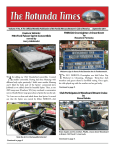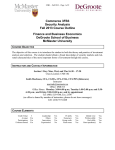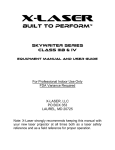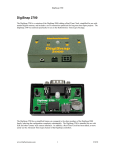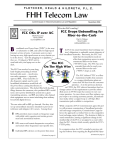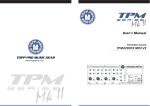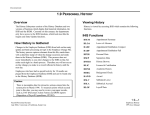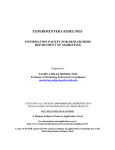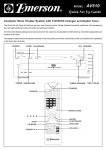Download Open newsletter in separate window
Transcript
SKYMASTERS RADIO CONTROL CLUB OF MICHIGAN JULY 2011 Chartered Club #970 11 Year Gold Leader Club 2011 Club Officers & Appointees... President: President: Vice Vice Pres: Pres: Secretary: Secretary: Treasurer: Treasurer: Editor: Editor: CFI CFI :: State State Park: Park: Membership: Membership: Greg Greg Cardillo Cardillo Neil Neil Krohn Krohn Dan Dan Stolz Stolz Bob Bob Donohue Donohue Mark Mark Smith Smith Ron Ron Sokacz Sokacz Bill Bill Stark Stark Randy Randy MacInnes MacInnes 2086 Cedar Key Ct. 722 722 Leinster Leinster 1311 1311 Pondview Ln. 3323 3323 Baldwin Baldwin Woods Woods 1955 1955 Hopefield 40714 40714 Matlock Matlock 1010 1010 E. E. Clarkston Clarkston 8189 8189 Easton Easton Rd Rd S. S. Lake Orion Rochester Rochester Oxford Lake Lake Orion Orion Lake Orion Sterling Sterling Hts Hts Lake Lake Orion Orion Clarkston Clarkston 48359 48309 48309 48371 48359 48359 48359 48310 48310 48362 48362 48348 48348 248-393-1056 248-375-0908 248-375-0908 248-236-0206 248-915-9791 248-915-9791 248-391-5970 586-977-1404 586-977-1404 248-693-8639 248-693-8639 248-394-0414 248-394-0414 President’s Message... It’s summertime in Michigan – after a very wet and windy spring, hopefully more flying time coming our way. This month I’m writing this in New Jersey and New York as I traveled back east to see family and friends. The Past Month Our Electric Fly managed to dodge the spring rains and wind this year – with a great turn out and lots of flying! See pictures and details inside. Our Student Days and Nights and Stony Creek Float Flying continued as weather allowed… Upcoming Events The next DNR Stewardship Work Day is Saturday, July 9th… They are looking for help to cut glossy buckthorn from areas around Graham Lakes. For those attending, insure you sign in as a Skymaster. We do receive credit against our lease for hours worked at these events! Our flying events continue for July. Warbirds and Scale is on July 17th. This has been one of our most popular events over the years. This is not intended as a precision scale contest – any plane resembling a full scale aircraft – military or civilian – is welcome to fly. Our Second Annual Helicopter Fun Fly is on July 31st! Our first event last year was very well attended with a range of helis from small electrics to larger glow – and even a turbine powered model. A wide range of flying from basic to 3D as well. Based on last year, we expect this event to last all day – weather permitting of course. Student Days continue on Mondays– from 10am till 2pm… and Student Night on Wednesdays from 3pm till 8pm – with pot luck dinner at 6pm… Remember we eat rain or shine – so come out and enjoy! Just bring some meat for the grill, a dish to pass, and your beverage choice (non-alcoholic) – and come enjoy! Families always welcome! Stony Creek Float Flying also continues on Wednesday mornings. If you are on our members email list, you have been receiving a weekly email highlight the events of the next week – both Skymasters events, and other area events we are aware of. I’ve received several positive comments about these… Thank you for the feedback and let me know what else would help… (and no – I’m not up at midnight every Sunday morning to send it… The autopilot is engaged!) (For other area clubs – if your event is listed on our site (http:// www.skymasters.org/events/ otherclubs.php) - it will be included in the weekly emails to our members… If your event isn’t there – let us know ( [email protected]) and we’ll get it added! Busy Month It has been a very busy month for me… with other activities taking me away a bit – so I haven’t seen many of you this month. My thanks to those who have continued to step up and take care of work needed at the field. Your efforts are all appreciated as we enjoy a beautiful flying site in Southeast Michigan! By the time you read this – I will be returning to Michigan and hope to see you out flying! Happy Landings! Greg ACCIDENTS CAN HAPPEN TO YOU!!! After a couple of years in mothballs I brought out my Rascal 110 that originally flew in 2003 and I reviewed in Radio Control Modeler in 2004. It was one of my shortest reviews as the airplane was perfect. There was nothing to write about except for “follow the directions”. I went on to convert it to electric (the weight of 36 NiCads-no LiPos yet) didn’t alter the flying characteristics a bit) and add Mark Smith floats for water flying. The Saito 180, after all that time unused, needed a lot of clean up. A Spektrum radio system was installed. I needed to check the engine and the throttle linkage set up on the radio so Chris and I brought it outside for a run up. The old Saito started instantly and sounded good. While still in front of the airplane I went to full throttle. The high end a little rich so I moved behind the prop for a high end needle valve adjustment. OK that was set. Back down to low throttle for a minute to see how it responded to acceleration. I punched the throttle and the Saito accelerated well but with a lot of smoke. Back down to low for a few minutes. As we waited I told Chris that I thought the low end was rich. He agreed. I wanted to try accelerating a few more times before shutting down for an idle mixture adjustment. With Chris holding on to the Rascal I quickly went to high throttle and back to low. Same conclusion. All right, one more time. I again punched it to high, only this time the outcome was dangerously different. There was smoke, a loud bang, the sound of metal bouncing on a hard surface and the sound of breaking glass. The engine had backfired, apparently from loading up from the rich low end mixture, and quit, throwing the prop and spinner in the process. The prop nuts (yes there were 2) were jammed against each other with an 8 inch wrench for plenty of torque. The APC 17 X 8, spinner, spinner backplate and prop nuts were no where to be found. Take a look at the pictures. Chris was the first to notice the broken basement window with the prop imbedded in the shards of glass. I pulled the prop out and laid it in front of the airplane. I looked forward to see the prop washer and nut about 12 feet straight ahead in the garage. We eventually located the spinner backplate under the flight box. But the spinner could not be found. We searched the garage and under the nearby cars parked in the driveway. Nothing! Bummed at the loss of the spinner (but grateful that no one was injured) I found a replacement prop, prop washer and prop nuts, started the engine and uneventfully completed the tuning the engine. It was nearly 2 hours later that I needed to go to the front yard. There in the middle of the yard was the spinner. It had traveled over 60 feet and flown over 3 cars including a minivan. The force of the prop and the spinner leaving the engine could have done great damage to me had I continued to stay in front of the airplane. Think about this too. The engine was not even at full throttle when this occurred. I think the spinner could have been in the next county if this occurred at maximum power. When some reminds you to move out of the prop arc take their advice. It could save your life. Please also keep this in mind (Continued on page 9) For many years Monday morning has been the Official Day for Retires to fly, now it is also our Student Day. Hi All, I want to continue this month with the topic of power by discussing my quest for a charger for my new Lipo's I bought for my 90 size electric pattern ship called the Osiris. I equipped the plane per recommendations as far as motor, speed control, servo's and wound up needing a new Lipo size and capacity for me. This plane takes a 5s 5000 Mah pack, which was much more Lipo than I have ever owned. One of the reasons I bought the Osiris is that it was specifically built for people who also own electric 2 meter pattern planes as the Osiris takes 1/2 the Lipo requirement that a 2 meter ship does. I am in the painting stages of a 2 meter pattern ship called the Black Magic and it will indeed take 2 of those big Lipo packs I just mentioned A 10s 5000 Mah configuration! I can fly 2 packs at once in my Black Magic, or fly 1 in my Osiris. After making the major decision itself to electrify both of these planes, the next decision was actually much more difficult. I had to determine how I would actually charge them. This is not as straight forward as it appears, and as you might guess, power calculations became critical in my decision. Besides power calculations, I found current and voltage limitations also came into play. Let's take a look at some of the basic calculations first. For a 5S pack, it has a charged voltage of 21 Volts, and a discharged voltage of 18.5 Volts. To charge this pack at a standard 1C, it requires ~5amps total to be "put in" the pack (assuming the pack was fully flat). This 5 Amps would also be the instantaneous current being put in for most of the charge until it got nearly fully charged. The first numbers I kept in mind during my fiddling around was that for each 5s 5000 pack, I would need ~100 Watts ( remember power = Amps*Volts =5Amps * 20 Volts= ~100Watts,) for a 1C charge ( I.E. charge completion in one hour, as is often recommended amount to charge any Lipo). Now, I began to think about some faster charging, like maybe 2, 3, or even 4C. At 2C, I should have a charged pack in 30 minutes, at 4C, it would be ready to go from flat in a mere 15 minutes! - my mind was racing with how many times I could fly this pack in a typical 2-3 hour visit to the field I normally have. Then I did the numbers. At 2C, the power needed would be at least 200Watts, a number which already disqualified almost every charger I had, but the second issue that reared up was that a 2C charge would require ~ 10Amps ( remember a 5000Mah pack is 5Amps, and a 2C is 10Amps). A 4C charge is even worse, at 400 Watts, and 20 Amps. Interestingly enough, the packs I bought claim they are capable of 10C charge. That would be 50 Amp charge current! I noticed many of the charges we use are actually not rated for much over 100Watts total or per port. For foamy and other small planes, this really is not much of an issue. Let's look at a 3s 2200 pack - a very common one by today's standards. A 3S pack is 11.5 volts nominal, and a 1C charge would be 11.5 Volts*2.2 Amps which is ~25 Watts. Most of our chargers can handle this. A 2C charge is still only ~50 Watts, with about 5 Amps of current. For most of us flying smaller stuff, the power and current limitations do not come into play. Back to my packs now though, I then started looking for a charger that could handle the pack size (at least 5s, and actually one day if I ever fly an electric heli, which use 6s), wattage, and current. I actually found a charger with the following specs ♦ 2 charge ports - I could charge two packs at once each charge port capable of 500 Watts. ♦ 20 Amps maximum per charge port. ♦ A maximum configuration of 7S per port. This clearly was not your average $20 dollar Hobby King special, I had found a charger that fit the bell! If I wanted, I could theoretically charge 2 of my 5s packs at 4C, even at the same time! Then I did the numbers. I now had to look at the power input to this situation. Once again those darn laws of physics came into play (like gravity at the field when I am flying) and I had to consider that in order for me to get all that power into the Lipos, I would have to start with more power than calculated due to heat and conversion losses. (Indeed, one of the major factors limiting power in electronics is heat dissipation). This wonderful charger I bought was strictly DC power in ( No wall plug here), so I started with how I was going to supply the necessary current and voltage to the charger. I already own a 15 Amp 12 Volt power supply, courtesy of Radio shack from many years ago. Let's look at it in use. I plugged in 2 of my 5S packs and set them both up to change at 1C. Well, I put an Ammeter on the line to my charger and noticed, much to my Skymasters Apparel To order Skymasters hats, shirts, jackets, etc. please call (Continued on page 9) Creative Embroidery at (248) 628-9351 or [email protected] (Continued from page 8) astonishment, that the charger was demanding ~13-14 Amps! - Oops, forgot about the fact that the charge process is only about 80% efficient, and that the extra amperage above 10 Amps ( 5 Amps per pack) was dissipated away as heat. I also forgot about the fact that my 5S pack needs to be given 22 Volts, not 12, so voltage was stepped up by converting it in the charger which used more current. Wow, my best power supply is at its limit and I am only charging at 1C! I was however, well within the output power limits of the charger, only pushing 100 Watts per port, at 5 Amps per pack. Upon further reading of the charger user manual, I noticed that the charger can take up to 29 Volts input and that the large packs I am charging require a 24 Volt input to charge at anything more than about 2C. This made sense to me, as the much higher currents involved in these charge rates makes enormous amounts of heat and a significant voltage "head" is needed. Remember the packs are 21 Volts when charged, so 12 volts will not cut the mustard here. I had my next brilliant idea. I already have a dual battery I bring to the field and I hook to my Dynatron glow starter. Here was my answer! Then I did the numbers. If I charged one of my packs at 4C, it would draw 20 Amps for ~15-20 minutes. The poor little tractor batteries I use would be exhausted after charging 1 to 2 packs. Then I thought about using those deep cycle marine batteries - that was the ticket then as you might be sick of hearing by now, I did the numbers. Two of those batteries (remember I needed 24Volts) would set me back near $400 and would weigh more than I could lift. Ok, now in a final last grasp attempt, I read about the folks who buy the small portable 2000 Watt gasoline generators, who then hook them to 24 Volt power supplies ( often 2 computer power supplies hooked in series), then hook up their charger to the 24 volt power supply. Well, let's look at that possibility. The power supplies need quality input power, so the $100 harbor freight generator would destroy those things in about 20 seconds, so I looked at a good 2000 Watt generator that uses an inverter to make clean power - 1500 bucks, Additionally, I would also need a power supply that would run $200-$400. All of this just because I thought I needed to charge the packs faster. Finally, I realized the reality of my situation. I notice that I spend lots of time at the field lying about my flying capabilities and other assorted non flying activities, so that I actually only fly any given thing I bring 3-4 times when I am at the field. How about I buy 4 packs, charge them leisurely at home at 1C and not worry about charging at the field? - Works for me. Yes, I realize that this situation is not mainstream, but I suspect as electric flying continues its steady increase at the field, electric airplanes will invariably grow and many more will run into this issue before long. The moral of this long story is that you have to keep in mind power requirements , along with current and voltage limitations for all phases of electric flight, not just motor calculations. Finally, I wanted to let you all know that I will be taking the rest of the summer off from this column so I can work on my fleet of planes that already needs help! - I will return in the fall. See ya at the field! Joe (Continued from page 3) when running up your engine on one of the stands. You may be behind your engine, but your fellow pilots may not be in a clear area. Joe Hass PS: Chris quickly stated “Mom has got to see this!” and brought Paula outside. She first looked at the window then at Chris and said “What did you do?” Chris quickly said “It wasn’t me – Dad did it”. That, of course, directed the attention to me. Perhaps I should have said “That window needed changing anyway”. COMPUTER CUT FOAM FLOATS ALL SIZES & SHAPES MARK SMITH 248-391-5970 SUN 3 MON 4 17 10 10 CHESANING Mid America Electric DAWN PATROL 17 CARDS HELI CARDS WARBIRDS GIANT SCALE & SCALE 24 24 RCCD 4 STROKE 31 HELI FLY 5 6 STONY & STUDENT 28 21 14 7 THU JULY 2011 12 13 STONY & STUDENT WED 19 20 STONY & STUDENT TUE 26 27 STONY & STUDENT 1 9 Mid America Electric 2 SAT 8 ROMEO 2’S EVENT FRI CARDS GIANT SCALE 23 CARDS HELI 16 22 30 16 29 Mark Smith 1955 Hopefield Lake Orion, MI 48359 Web site: www.skymasters.org Email: [email protected] PHOTOGRAPHY by Greg Cardillo and Fred Engelman Skymasters Information…... Skymasters field is located within the Bald Mountain State Park on Scripps Road (see map). State Park Permits are required and can be obtained from the Park Headquarters located on Greenshield Road or at club events. Flying is permitted from 10 AM to 8 PM. The noise limit is 94 dBa at 10 feet— this noise rule is strictly enforced. In the summer, Wednesday evenings are Student Nights and there are usually instruc- tors around all day. Student night is also a pot luck buffet, bring something for the grill & a dish to pass. Meet the Instructors and arrange for more instruction time together on other days. Our Chief Flight Instructor is Ron Sokacz (586) 977-1404. From June to August, Club meetings are held at the field, on the s e c o n d Wednesday of the month at 8 PM . A great chance to fly and socialize. Winter meetings—September to May—are held at Larson Middle School (on Long Lake just east of John R—see map) on the second and fourth Wednesday of the month at 7:00 PM. Bring a model for Show and Tell, enjoy coffee with donuts and listen to the speaker of the evening. The Skywriter newsletter is sent to members, local hobby shops, and other R/C clubs in the area and around the country. All contributions are welcome. Please send articles to the Editor. If you know of anyone who may be interested in R/ C Aviation, please give them a copy of this newsletter or a copy of an AMA magazine. It may spark their interest!
















